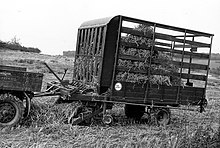Loading wagons
The loader wagon or hay loader is a harvesting machine with which crops such. B. cut grass , hay , straw or beet leaves can be loaded mechanically in one-man operation.
functionality
The loading wagon is a trailer with a converted cargo space. The crop is picked up from the ground by means of a pushed or pulled pick-up drum with flexible spring tines mounted under the front of the wagon and pushed into the conveyor channel. There a powerful drum, the so-called loading rotor , or a conveyor rocker with rigid tines picks up the material and pushes it into the loading space. Another variant is the use of a rake conveyor , which today is only used by the Agrar-Landtechnik company in Balterswil (CH). The machine factory Otto Gruber from Austria uses push rods as a third alternative as a conveyor unit.
The loading space is equipped with a scraper floor . Usually ropes are stretched from front to rear so that there is a closed transport space for the comparatively coarse material. As a result, the compression by the loading rotor can take place more intensively. Many loading wagons are equipped with distribution rollers at the rear end for more even unloading in silos or for targeted unloading in the stable aisle.
In order to shred the load, a cutting device can optionally be switched on in the conveyor channel. The cutting devices usually have 10 to 35 knives, but sometimes up to 74 knives. The crop can be cut into pieces 4 to 8 cm in length with these. However, the accuracy and quality of the cut cannot be compared with that of a forage harvester .
The pick-up, conveyor drum, cutting unit, scraper floor etc. are driven by the pulling tractor via a PTO shaft . Despite the high loading capacity, the power requirement of the loading wagons is comparatively low; a wagon with 25 m³ loading volume can be operated with a 25 kW tractor. The capacity of the loading wagons produced varies between around 10 and 60 m³.
Silage wagons or combi wagons are loading wagons that are built to be extra sturdy so that they can be filled with forage harvesters as an alternative. The transport of maize silage in particular places higher demands on the stability of the structure. The pickup can be dismantled for such purposes. The conveyor shaft must then be closed with a base plate.
Self-propelled wagons are also built. The self-propelled vehicles are mainly used in mountainous areas, as they can be designed to be very agile and suitable for slopes (see, for example, the Reform Muli ). For better economy, the self-propelled machines can also be used, for example, for spreading fertilizer or spreading liquid manure by changing the body.
history
Before the invention of the loading wagon, the hay had to be loaded onto large wagons (e.g. carts ) to which a so-called white tree was tied at the top so that the load held together.
The forage wagon was presented to the public for the first time in 1960 at the DLG exhibition in Cologne by the inventor Ernst Weichel . The device already had the name "Hamster", the generic name "Loading wagon" did not exist back then. To simulate loading wagon loading, the inside of the gate structure was lined with grass mats. At one point there was a gap in which pictures of the other Weichel products were shown using a slide projector .
Before the presentation in Cologne in 1960, the loader wagon was not tested once under real conditions. It was not until autumn 1960 that Ernst Weichel found time to continue working on the project. He modified the front wall of the wagon a little, moved the support wheel in the middle to its side and then tried it out with his Unimog loading straw on a harvested field (see picture). In the picture below you can see that it worked right away. Here the content is unloaded using a scraper floor. It took until 1976 until the patent application DE 11 60 229 filed in 1960 was granted a patent after lengthy patent litigation .
The first loading wagons did not have knives and therefore required more work than the old method when unloading. Furthermore, the compression of the hay was not high enough. However, after initial skepticism from the professional world, the loader wagon found widespread acceptance because the workload was reduced to a tenth. Within a decade, 50% of grassland farms switched to loading wagons. In the early 1990s, self-propelled forage harvesters often replaced the self-loading wagon . In the meantime it is experiencing a renaissance, as it is superior to the forage harvester in terms of fuel consumption and slope capability (low-level loading wagons) and new models with a large loading volume have been developed.
literature
- Horst Eichhorn (editor), Landtechnik, 7th edition, Ulmer, Stuttgart, 1952, 1999, ISBN 3-8001-1086-5
Web links
Individual evidence
- ↑ Bibliographic data: DE1160229 (B) - 1963-12-27 , on worldwide.espacenet.com, accessed on September 21, 2018





